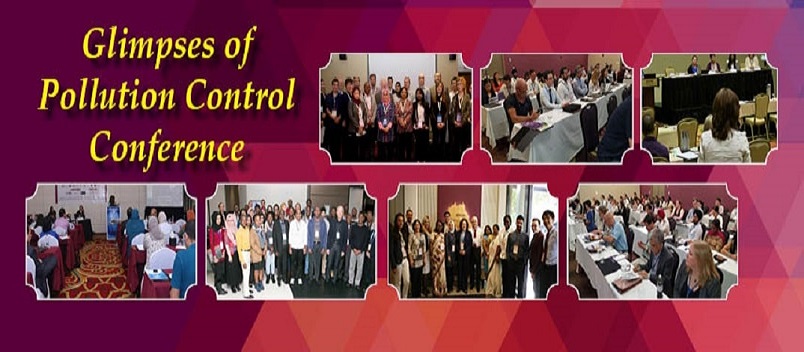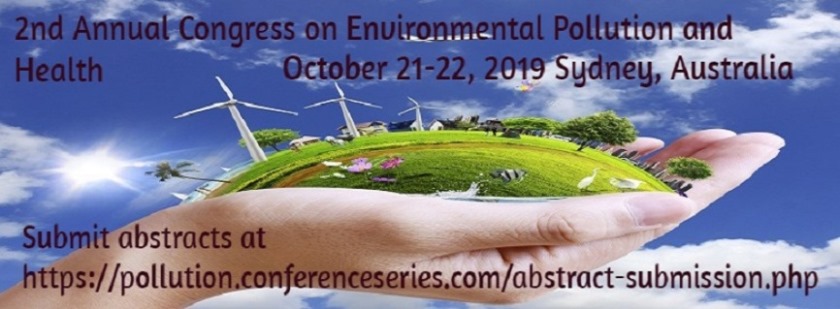Theme: Sustainable Environmental Practices for Reducing Global Pollution and related Health hazards
Pollution and Health 2019
Pollution and Health 2019, takes an immense pleasure to extend a warm welcome to invite all the participants across the world to attend our upcoming congress on 2nd Annual Congress on Environmental Pollution and Health during October 21-22, 2019 at Sydney, Australia. The deliberations for Pollution and Health 2019 will be on “Sustainable Environmental Practices for Reducing Global Pollution and related Health hazards”.
Pollution and Climate change is the present most serious problem in the world. Due to rapid industrialization and urbanization, our environment is getting polluted and in turn effecting the surrounding ecosystem. If this is not properly addressed soon, our future generations will be facing devastating results in the form of natural disasters that costs the lives and health on planet earth. So, with the prime motto to bring awareness in the common people, Pollution Control Conferences are being organised every year. As well it brings the world class environmental professionals and policy makers to frame strategic action plans and policies to control and cease the enormous release of pollutants into the environment. Pollution Control Conferences brings both the researchers and stakeholders on one platform to share and come with possible positive output. Pollution Control Conferences is the best platform for professional development and networking opportunities. It is the best opportunity for the young researchers to meet the world class Scientists and Environmental Professionals.
This Pollution Control Congress is an amalgam of invited keynote Lectures, Scientific Sessions, Poster presentations, Workshops related to current scenario, issues and future challenges associated with Pollution control and public health sector.
We look forward to seeing you in Sydney, Australia
Environmental pollution is one of the most serious problems facing humanity and other life forms on our planet today. Environmental pollution can be defined as any harmful substance that is been introduced into the environment via air, water, soil etc. These harmful substances that cause pollution are termed as Pollutants. Due to excessive increase in the pollutants, normal environmental processes are adversely been affected. Depending on the nature of pollutants and subsequent pollution of environmental components, the pollution may be categorized as Air Pollution, Water Pollution, Soil/Land Pollution, Noise Pollution, Radioactive Pollution, and Thermal Pollution. Among these types of pollution, air pollution is the main type threatening the environment, humans, plants, animals, and all living organisms.
Conference series llc Ltd every year organises related international Pollution Conferences | Pollution Control Conferences | Air pollution Conferences | Water Pollution Conferences | Global Warming Conferences | Climate Change Conferences | Environmental Conferences across the world.
Related Pollution Control Agencies | Pollution Control Societies | Pollution Control Boards | Pollution Control Associations are the major contributors in our Pollution Control conferences
Track 2: Climate Change and Global Warming
Climate change can be defined as the change in the weather patterns of earth that lasts for few decades and sometimes may be for million years. Climate change is the trending and threatening issue of our time and if it is not addressed with immediate attention, then our planet earth should be ready to face severe catastrophic impacts in the future. Global warming is the defined as gradual rise in the average temperature of the Earth's atmosphere due to change in the climate. Primary reasons for the global warming are due to industrialization and urbanization especially CO2 emissions. Major consequences due to climate change and global warming are Sea Level Rise, Ocean warming, Glacial Retreat, Shrinking of Ice Sheets, Solar Irradiance, Depletion of Ozone Layer, Natural disasters and Droughts and Heat Waves.
Conference series every year organises related international Pollution Conferences | Pollution Control Conferences | Air pollution Conferences | Water Pollution Conferences | Global Warming Conferences | Climate Change Conferences | Environmental Conferences across the world.
Related Pollution Control Agencies | Pollution Control Societies | Pollution Control Boards | Pollution Control Associations are the major contributors in our Pollution Control conferences
Track 3: Ocean and Climate change
Environmental Testing Market: By Sample (Wastewater, Soil, Water, & Air), By Contaminant (Heavy Metal, Microbiological, Organic, Residue & Solids), By Technology (Conventional & Rapid) - Forecast (2017 - 2022)
The Global Environmental Testing Market is segmented into sample, contaminant and technology. On the basis of sample the market is segmented into soil, water, air and waste water whereas contaminants category includes: heavy metals, microbiological contaminants, solids, residues and organic compounds. Sample testing for contaminants is done by manufacturing companies in order to ensure the compliance of waste or the disposals with environmental standards.
Environmental Testing Market is also segmented by technology in two methods:
- Conventional Method
- Rapid Method.
Conventional method includes dissolved oxygen determination in water analysis, chemical and biological oxygen demand and culture plate method to detect presence of microbes whereas rapid method includes immunoassay-based methods, hybridization-based technology, advanced spectrometry-based technology, biosensors application, fast in-house testing and chromatography-based technology.
Market size and forecast is provided for the regions of APAC, Europe, North America and RoW. A detailed qualitative analysis of the factors responsible for driving and restraining growth of the Environmental Testing market and future opportunities are provided in the report. This report on the global environment testing market identifies many such insights and M&A opportunities, besides providing a detailed analysis of the market.
Sample Companies Profiled in this Report are:
- Asurequality Limited(New Zealand)
- Bureau Veritas S.A.(France)
- Environmental Testing, Inc(U.S.)
- Eurofins Scientific(Luxembourg)
- Intertek Group Plc(U.K.)
- 30+.
Scope and Importance:
Environment is constituted by the associating frameworks of physical, organic and social components between related in different routes, separately and by and large. These components might be clarified as under: (1) Physical components Physical components are as space, landforms, water bodies, atmosphere soils, rocks and minerals. They decide the variable character of the human natural surroundings, its chances and also impediments. (2) Biological components Organic components, for example, plants, creatures, microorganisms and men constitute the biosphere. (3) Cultural components Social components, for example, financial, social and political components are basically synthetic highlights, which make social milieu Significance of Environment Studies: the earth contemplates illuminate us, about the significance of insurance and preservation of our aimless arrival of contamination into the environment. At present an extraordinary number of environment issues, have developed in size and unpredictability step by step, undermining the survival of humanity on earth. We learn about these issues other than and compelling recommendations in the Environment Studies.
Why Sydney?
Sydney, capital of New South Wales and one of Australia's largest cities, is best known for its harbor front Sydney Opera House, with a distinctive sail-like design. Massive Darling Harbor and the smaller Circular Quay port are hubs of waterside life, with the arched Harbor Bridge and esteemed Royal Botanic Garden nearby. Sydney Tower’s outdoor platform, the Skywalk, offers 360-degree views of the city and suburbs.
Conference Highlights:
- Environmental Pollution
- Pollution Sources & Effects
- Global warming
- Ocean and Climate change
- Pollution Analysis
- Pollution Ecology & Toxicology
- Environmental Protection
- Human Impact on the Environment
- Environmental Sustainability and Development
- Pollution Solutions
- Recycling & Waste Management
- Bioenergy and Biofuels
- Risk assessment
- Trending Market in Pollution Control
Why to Attend??
Pollution and Health 2019 conference will feature 14 technical sessions, a poster session, exhibit hall, keynotes lectures and Special feature includes student workshop.
Pollution and Health 2019 is a perfect platform for environmentalists, researchers, scientists, decision makers and students to come together, compare findings, and discuss the science of the future. Share your research with an engaged audience of your peers from around the globe. Learn from scientific trail blazers who are designing more sustainable processes for achieving a pollution controlled environment.
Noble laureates, Presidents, Vice-presidents, Deans, Chairs, Co-chairs, Department Heads, Environmentalists, Researchers, PhD Students, Non-PhD Students, etc.. Vendors will have the opportunity to introduce the latest advancements in Environmental pollution control technologies to a diverse audience by becoming a conference sponsor via exhibits or workshops.
- Academia 41%
- Researchers 25%
- Industries 20%
- Students 12%
- Others 3%
Top Societies Associated with Pollution Control Research
Around the Globe
- The International Biometrics Society (Australasian Region)
- The International Environmetrics Society (TIES)
- American Statistical Association Section on Statistics and the Environment
- International Environmental Modelling and Software Society (iEMSs)
- Royal Statistical Society Environmental Statistics Section
- Worldwide pollution Control Association
- Environmental Protection Agency
- National Association of Clean Air Agencies
- Air & Waste Management Association
- Cen SARA (Central States Air Resource Agencies)
- USDA Agricultural Air Quality Task Force
- Air Pollution Control Equipment Manufacturers Association of Australia
- Australian Marine Sciences Association
- Total Air Pollution Control (TAPC) Sydney, Australia
- The Australian Water Association
- Ecological Society of Australia
- The Environment Institute of Australia and New Zealand
- Food & Agricultural Organisation of the United Nations
- Australian Institute of Environmental Health
Conference Highlights
- Environmental Pollution
- Pollution Sources & Effects
- Global warming
- Ocean and Climate change
- Pollution Analysis
- Environmental Protection
- Pollution Ecology & Toxicology
- Human Impact on the Environment
- Environmental Sustainability and Development
- Pollution Solutions
- Recycling & Waste Management
- Bioenergy and Biofuels
- Risk assessment
To share your views and research, please click here to register for the Conference.
To Collaborate Scientific Professionals around the World
| Conference Date | October 21-22, 2019 | ||
| Sponsors & Exhibitors |
|
||
| Speaker Opportunity Closed | Day 1 | ||
| Poster Opportunity Closed | Click Here to View | ||
Useful Links
Special Issues
All accepted abstracts will be published in respective Our International Journals.
- Journal of Pollution Effects & Control
- Journal of Ecosystem & Ecography
- Journal of Environmental Analytical Chemistry
Abstracts will be provided with Digital Object Identifier by


















